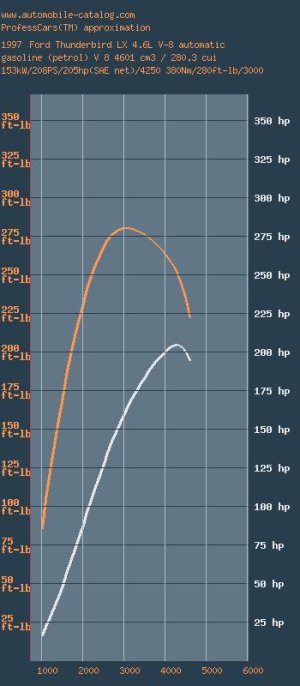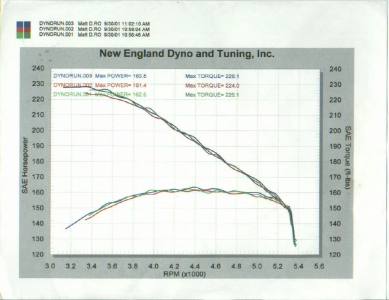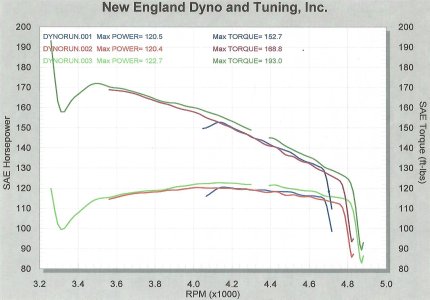You are using an out of date browser. It may not display this or other websites correctly.
You should upgrade or use an alternative browser.
You should upgrade or use an alternative browser.
Stock Dyno Graphs
- Thread starter 1997ThunderbirdLXV6
- Start date
- Joined
- Sep 12, 2023
- Messages
- 2,395
- Location
- North Ridgeville, OH
- Cars in Garage
- 2
- Vehicle Details
- 1997 Thunderbird 4.6, 1998 Mark VIII LSC
They seem to be a computer-generated model for BHP. No factory MN12 puts down 205 WHP - most dyno in the 160-165 WHP range. I'll see if I can dig up some actual dyno graphs from years past...
- Joined
- Sep 12, 2023
- Messages
- 2,841
- Location
- Charlotte, NC
- Cars in Garage
- 1
- Vehicle Details
- '95 Thunderbird with '18 TF 5.3L - SVO Engine
They do match Ford’s “Claimed” HP Ratings for the motors.
- Joined
- Sep 12, 2023
- Messages
- 2,395
- Location
- North Ridgeville, OH
- Cars in Garage
- 2
- Vehicle Details
- 1997 Thunderbird 4.6, 1998 Mark VIII LSC
- Joined
- Sep 12, 2023
- Messages
- 2,395
- Location
- North Ridgeville, OH
- Cars in Garage
- 2
- Vehicle Details
- 1997 Thunderbird 4.6, 1998 Mark VIII LSC
As for you N/A 3.8 guys, it's hard to find people who have dyno'd their stock 3.8s. 
However... I found this lightly modded '89 3.8 dyno graph (full dual 2.5" exhaust). Not the easiest to read, but it's the only one I found. Also of note is the OP of this dyno graph said the tach was off - the displayed RPM is 33% low. 2000 RPM is actually 2666, 2500 is 3333, 3000 RPM on the chart is actually 4000; 3500 is 4666 etc.


However... I found this lightly modded '89 3.8 dyno graph (full dual 2.5" exhaust). Not the easiest to read, but it's the only one I found. Also of note is the OP of this dyno graph said the tach was off - the displayed RPM is 33% low. 2000 RPM is actually 2666, 2500 is 3333, 3000 RPM on the chart is actually 4000; 3500 is 4666 etc.

it's hard to find people who have dyno'd their stock 3.8s.
You don't say!
They got 250 lb-ft. out of it just from adding dual exhaust?
- Joined
- Sep 12, 2023
- Messages
- 2,395
- Location
- North Ridgeville, OH
- Cars in Garage
- 2
- Vehicle Details
- 1997 Thunderbird 4.6, 1998 Mark VIII LSC
I doubt it... after all, it is a number-happy DynoJet. 
In all seriousness, it's possible the numbers are also off because of the incorrect tach readout too. Until someone boldly and bravely goes to dyno their stock 3.8, we may never know!
In all seriousness, it's possible the numbers are also off because of the incorrect tach readout too. Until someone boldly and bravely goes to dyno their stock 3.8, we may never know!

- Joined
- Sep 13, 2023
- Messages
- 1,275
- Location
- Franklin, MA
- Cars in Garage
- 1
- Vehicle Details
- 1997 Thunderbird LX 3.8L/4.2 Wannabe
I'll have to dig mine out, did it twice over 20 years ago. The second time Jerry tweaked it a little bit! 
Joe

Joe
- Joined
- Sep 13, 2023
- Messages
- 1,275
- Location
- Franklin, MA
- Cars in Garage
- 1
- Vehicle Details
- 1997 Thunderbird LX 3.8L/4.2 Wannabe
- Joined
- Oct 2, 2023
- Messages
- 1,566
- Location
- New Mexico
- Cars in Garage
- 1
- Vehicle Details
- 1994 Mercury Cougar XR7, 3.8L, all stock
<crying with tears of "why, why did i get a V6???">
It's a good solid engine (once the head gaskets are addressed) and it will run forever with proper maintenance. They are capable of extremely respectable highway mileage numbers even in our cars. They just don't make a ton of power.<crying with tears of "why, why did i get a V6???">
The great enjoyment I get out of my car, including its V6, has been well documented on here. But I also understand that among automotive enthusiasts, when two engine variants are available, the more powerful one is preferred.
The 4.6 has a lot going for it. I mean it powered millions of limousines, police cruisers, and cabs. It's an American institution. Having lived in NYC for many years in the early 2000s, that engine literally ran our city.
The 3.8 on the other hand went into a lot of transverse FWD cars/vans, and I think that tarnished its reputation a little bit. I have only done basic stuff on my engine; I'm not the most mechanical. Think plugs/wires, crankshaft sensor, belt. I imagine that any one of these would be a huge pain on a transverse car, with barely enough room to get your hands in there. And if mechanics hate working on a car, the engine's reputation suffers with it.
The 4.6 has a lot going for it. I mean it powered millions of limousines, police cruisers, and cabs. It's an American institution. Having lived in NYC for many years in the early 2000s, that engine literally ran our city.
The 3.8 on the other hand went into a lot of transverse FWD cars/vans, and I think that tarnished its reputation a little bit. I have only done basic stuff on my engine; I'm not the most mechanical. Think plugs/wires, crankshaft sensor, belt. I imagine that any one of these would be a huge pain on a transverse car, with barely enough room to get your hands in there. And if mechanics hate working on a car, the engine's reputation suffers with it.
dDUBb
PostWhore
But I also understand that among automotive enthusiasts, when two engine variants are available, the more powerful one is preferred.
The V6 was the most powerful engine available for the MN12 ..
It is just seen as a quick and dirty V6 when Ford needed something in the early 80's to fill that gap. It is just a boring pushrod 90 degree V6. It doesn't have variable valve timing and/or dual overhead cams and aside from the SuperCoupe (which nobody knows anything about anyway) it never really made any big power (maybe less so with the later split port engines). It had a reputation for blowing head gaskets. They aren't spectacularly great at anything. All of those things cemented its reputation long before anyone would car if it were installed in a FWD car. I think they are fine little engines that get no respect and who cares. If I cared what anyone else thought I'd be driving a Mustang. They share a surprising amount in common with the Buick 3800 which is seen as one of the better pushrod engines of its time. The difference is GM started with crap and kept refining it and making it better. Ford just kept making it and other than MPFI didn't do a ton to it and that's okay. We still love it.
I disagree I get compliments all the time with my SC. As far as power goes it was good for it’s time. Early 90’s cars just didn’t put out high hp engine’s back then with the exception of maybe a few specialty cars. The SC does have a nice torque curve to it so it does pick up fast. I just used to have a old 89 Base model and now I have a SC, I just don’t think they should be compared because they are different in a lot of ways.It is just seen as a quick and dirty V6 when Ford needed something in the early 80's to fill that gap. It is just a boring pushrod 90 degree V6. It doesn't have variable valve timing and/or dual overhead cams and aside from the SuperCoupe (which nobody knows anything about anyway) it never really made any big power (maybe less so with the later split port engines). It had a reputation for blowing head gaskets. They aren't spectacularly great at anything. All of those things cemented its reputation long before anyone would car if it were installed in a FWD car. I think they are fine little engines that get no respect and who cares. If I cared what anyone else thought I'd be driving a Mustang. They share a surprising amount in common with the Buick 3800 which is seen as one of the better pushrod engines of its time. The difference is GM started with crap and kept refining it and making it better. Ford just kept making it and other than MPFI didn't do a ton to it and that's okay. We still love it.
Last edited:
- Joined
- Sep 12, 2023
- Messages
- 2,395
- Location
- North Ridgeville, OH
- Cars in Garage
- 2
- Vehicle Details
- 1997 Thunderbird 4.6, 1998 Mark VIII LSC
With my old '94 Cougar (which had the 3.8) I never found its ability to get around during normal driving to be lacking due to poor engine performance. That said, when I needed to get going quickly - that's when the lack of power showed itself. The lack of weight on the nose improved steering response and cornering manners tremendously too. Combine V8 power with the V6 handling... it's easy for me to see why the SC was such an enthusiast's car.
Out of all the factory equipped options in the MN12 and its derivatives, the V8 still takes the power crown - if you include the FN10 and its 4v! After all, they DID fit that engine into the MN12 at the factory, they just never sold it to the public!
Though it is pretty apparent it's not particularly gutsy down low. Stall! Give me more stall!
Out of all the factory equipped options in the MN12 and its derivatives, the V8 still takes the power crown - if you include the FN10 and its 4v! After all, they DID fit that engine into the MN12 at the factory, they just never sold it to the public!

Though it is pretty apparent it's not particularly gutsy down low. Stall! Give me more stall!
when I needed to get going quickly - that's when the lack of power showed itself.
Perfect example for this: I pull into a long-stretch freeway on-ramp, I accelerate along the ramp, and by the time I reach the merge I'm already at say 60 mph. Only problem, I only now see that someone is cruising leisurely in the lane right next to me. So to merge, I have to either speed up very quickly, or slow down to let him pass and then speed up again, all within the confines of the remaining on-ramp.
In a fast car, I'd just speed up and pull ahead. In my V6 Thunderbird, well, that's impossible because at 60 mph, any remaining acceleration is "gradual".
Once you know the car, you simply plan ahead accordingly. On on-ramps where there's no clear view of the freeway until merging, I go up the on-ramp relatively slowly; then when I can see a gap in traffic, I step on it.
The V6 was the most powerful engine available for the MN12 ..
Well, I was thinking 1997 which is the model year of those two charts.
Generally speaking, and nobody get mad at me, I tend to forget about the SC, likely because I'm not the sporty type. I'm more into the whole personal luxury car plushness thing.
I also have to say that today's obsession with forced induction is getting a bit old. I mean some modern engines are turbocharged and supercharged. When you drive an old car, and especially if you're like me fairly new to even doing minor work on an engine, all that superfluous plumbing is a bit intimidating.
dDUBb
PostWhore
Well, I was thinking 1997 which is the model year of those two charts.
If we are talking 1997 model year specific - yeah, I'd spring for the V8 over the V6.
Generally speaking, and nobody get mad at me, I tend to forget about the SC, likely because I'm not the sporty type. I'm more into the whole personal luxury car plushness thing.
The SC is just as plushy .. usually equipped fully loaded; but having the 5 speed transmission over the auto makes it a lot more sporty. Id call the auto SC luxury and the stick sporty.
I also have to say that today's obsession with forced induction is getting a bit old. I mean some modern engines are turbocharged and supercharged. When you drive an old car, and especially if you're like me fairly new to even doing minor work on an engine, all that superfluous plumbing is a bit intimidating.
What superfluous plumbing ? Most kits are just an intake manifold swap.
Last edited:
- Joined
- Oct 2, 2023
- Messages
- 1,566
- Location
- New Mexico
- Cars in Garage
- 1
- Vehicle Details
- 1994 Mercury Cougar XR7, 3.8L, all stock
Ford modeled the Ford V6 after the Buick V6. Though they won't admit it. And yes, GM does / did have a better V6. Look what Buick did with the Grand National. I will say I am impressed with what Ford did with the 2.3l 4 banger in the SVO Mustang. Awesome feat.They share a surprising amount in common with the Buick 3800 which is seen as one of the better pushrod engines of its time. The difference is GM started with crap and kept refining it and making it better. Ford just kept making it and other than MPFI didn't do a ton to it and that's okay. We still love it.
- Joined
- Oct 2, 2023
- Messages
- 1,566
- Location
- New Mexico
- Cars in Garage
- 1
- Vehicle Details
- 1994 Mercury Cougar XR7, 3.8L, all stock
Not for the weak mechanic, that is for sure....... all that superfluous plumbing is a bit intimidating.
- Joined
- Sep 12, 2023
- Messages
- 4,961
- Location
- Roselle, IL
- Cars in Garage
- 1
- Vehicle Details
- 1994 Cougar XR7 DOHC TR3650
Ford modeled the Ford V6 after the Buick V6. Though they won't admit it. And yes, GM does / did have a better V6. Look what Buick did with the Grand National. I will say I am impressed with what Ford did with the 2.3l 4 banger in the SVO Mustang. Awesome feat.
Ford screwed the pooch with the aluminum heads, Buick stuck with iron into the 3800era.
- Joined
- Oct 2, 2023
- Messages
- 1,566
- Location
- New Mexico
- Cars in Garage
- 1
- Vehicle Details
- 1994 Mercury Cougar XR7, 3.8L, all stock
I have both, a 4.6l in my Town Car and a 3.8l in the Cougar. The Town Car over shadows the Cougar 10 fold in dependability, longevity and drive.
I was getting some parts at a NAPA one time years back, and the guy behind the counter was an ex-drag racer/ builder. Had pictures all over the front all of his achievements. When I was chatting with him about the V6, he said they (Ford) should never have put that small engine in a heavy car like the Cougar / Thunderbird. I tend to agree.
It is what it is. I tend to think that the Lincoln engine was built better than the Ford 4.6l and why they last so much longer with no major maintenance, but the V6 as my wife says "is the love of my life". Like good potato chips, you just can't stop.... no matter how abusive it is to you.
I was getting some parts at a NAPA one time years back, and the guy behind the counter was an ex-drag racer/ builder. Had pictures all over the front all of his achievements. When I was chatting with him about the V6, he said they (Ford) should never have put that small engine in a heavy car like the Cougar / Thunderbird. I tend to agree.
It is what it is. I tend to think that the Lincoln engine was built better than the Ford 4.6l and why they last so much longer with no major maintenance, but the V6 as my wife says "is the love of my life". Like good potato chips, you just can't stop.... no matter how abusive it is to you.
Similar threads
-
-
-
MN12/FN10s getting some love on Autoblog
- Started by theterminator93
- Replies: 1
-
For Sale Parts From Today's Junkyard Crawl
- Started by 1997ThunderbirdLXV6
- Replies: 12
-







